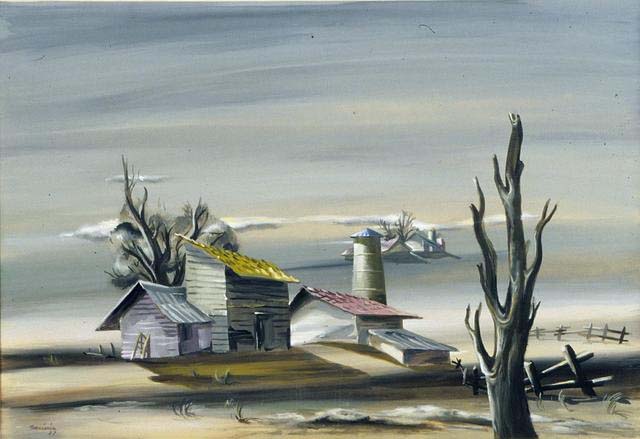Discussion: Two Visions of Illinois Farming in the 1930s

Frances Badger and Ray Breinin both interpreted Illinois Farms during their employment in the Illinois Works Progress Administration (WPA) Federal Arts Program. Their two paintings reveal two very different visions of farming. One is romantic and nostalgic, while the other is bleak and foreboding. They are two reactions to the Depression. Study the two paintings and discuss their meanings by way of the questions below. The paintings are Frances Badger's Autumn in Illinois and Ray Breinin's Dead Tree. Click on the images to enlarge them.

1. Look up nostalgia in the dictionary. How does the meaning of the word apply to Frances Badger's depiction of farming in Illinois? Is she looking back or forward in time? Name the specifics in the image that cause it to be called nostalgic? Is it at all realistic, and if so, how?
2. Breinin's farm is certainly not nostalgic. What adjective would you use to describe his interpretation? List the specifics in the image that made you choose that adjective. Is there anything realistic about the depiction of the farms? Social realism was one theme of the WPA artists who looked at American society during the Depression and depicted the poverty and despair as a way of social protest.. What is the social realism involved in this image of 1930s farming? How is the title indicative of the artist's views?
3. What characteristics would you expect to find in paintings of Illinois farms today? What are come of the changes that have happened in farming since the 1930s? List some positive and negative changes that an artist might portray. What could be some evocative titles for contemporary farm paintings?
(This lesson addresses National Visual Art Standards 4, Grades 5-8: Students analyze, describe, and demonstrate how factors of time and place (such as climate, resources, ideas, and technology) influence visual characteristics that give meaning and value to a work of art; Grades 9-12: Students analyze relationships of works of art to one another in terms of history, aesthetics, and culture, justifying conclusions made in the analysis and using such conclusions to inform their own art making.)






